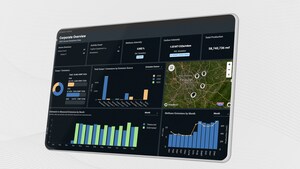
DENVER, Nov. 12, 2025 /PRNewswire/ -- Project Canary, the leading provider of emissions management solutions for the energy industry, today announced the publication of three independent, peer-reviewed studies. Together, these studies provide a new reference point for transparent, scientifically validated methane measurement. This peer-reviewed body of work combines results from more than 120 operating sites, multi-source quantification modeling, and rigorous testing in both controlled and real-world settings. Published in ACS ES&T Air, Atmospheric Measurement Techniques, and Sensors, the papers confirm the accuracy, reliability, and scalability of Project Canary's methane operational intelligence platform.
"Our approach leverages multiple measurement technologies and models to achieve the best cost-adjusted outcomes, with clear boundaries for where each technology performs best," said Will Foiles, Chief Executive Officer of Project Canary. "Peer-reviewed results show continuous monitoring works in the field. With effective models and workflows, teams detect problems sooner, estimate more accurately, and transform measurements into decisions."
Key Findings and Results:
1. Optimizing Continuous Monitoring Network Design
ACS ES&T Air, published July 2025.
It is a common misconception that continuous monitoring only detects emissions when weather conditions are ideal, especially wind speed and direction. In reality, these "blind time" periods caused by suboptimal weather conditions are far less frequent than many assume. Using data from 124 operating facilities, the study demonstrates that three well-placed sensors can limit blind time to under 10% and reliably detect events within an average of 80 minutes. Furthermore, adding more than three or four sensors offers diminishing returns, providing clear guidance for designing cost-effective and reliable systems.
2. Quantifying Complex, Real-World Emissions
Atmospheric Measurement Techniques, published October 2025
Another common critique of continuous monitoring is its ability to detect short, erratic emissions that overlap with regular operational activity. To address this, researchers tested multiple modeling techniques using 82 days of controlled, multi-source asynchronous releases – emissions starting and stopping at different times and locations to mimic real operations.
The study used a probabilistic inversion model that employs wind and concentration data to estimate both the location and the rate of methane emissions. With realistic dispersion modeling and high-frequency wind data, this approach allowed for accurate total-site quantification and precise leak detection. These findings support the use of continuous monitoring for measurement-based reporting and better emissions inventories.
3. Validating Reliability in Complex Field Conditions
Sensors, published April 2025.
Continuous monitoring is often evaluated based on how it measures single events, yet its greatest value lies in its ability to produce comprehensive data over time. This study evaluated 28 days of overlapping emissions at Colorado State University's METEC facility, revealing a cumulative mass error of less than 4 percent. The results confirm that the system maintains consistent performance under dynamic, real-world conditions, reinforcing its importance for measurement-informed inventories.
Setting a New Benchmark for Methane Measurement
Before these studies, fixed-point continuous monitoring lacked broad, peer-reviewed validation for site-level detection performance and quantification accuracy. These results change that. As hardware converges, the differentiator is now the analytics on top.
Project Canary's methane operational intelligence platform ingests data from multiple fixed-sensor vendors and other measurement sources, then applies physics-based and statistical models to deliver fast detection, accurate localization, and decision-grade quantification. With more than 10 billion high-frequency data points from nearly 40 leading blue-chip operators, Project Canary continues to advance credible, field-validated methane measurement.
About Project Canary
Project Canary is a climate data and technology company. Its methane operational intelligence platform transforms high-frequency field measurements into verified, decision-ready insights for operators, regulators, and investors. The company's solutions support faster mitigation, better inventories, and transparent environmental performance based on peer-reviewed science.
The studies are published in peer-reviewed journals. Full methodologies and results are available via the cited DOI links:
ACS ES&T Air
A Framework for Optimizing Continuous Methane Monitoring System Configuration for Minimal Blind Time: Application and Insights from over 100 Operational Oil and Gas Facilities
https://doi.org/10.1021/acsestair.4c00280
Atmospheric Measurement Techniques (AMT)
Performance Evaluation of Multi-Source Methane Emission Quantification Models Using Fixed-Point Continuous Monitoring Systems
https://doi.org/10.5194/amt-18-5375-2025
Sensors
Performance Evaluation of Fixed-Point Continuous Monitoring Systems: Influence of Averaging Time in Complex Emission Environments https://doi.org/10.3390/s25092801
SOURCE Project Canary








Share this article